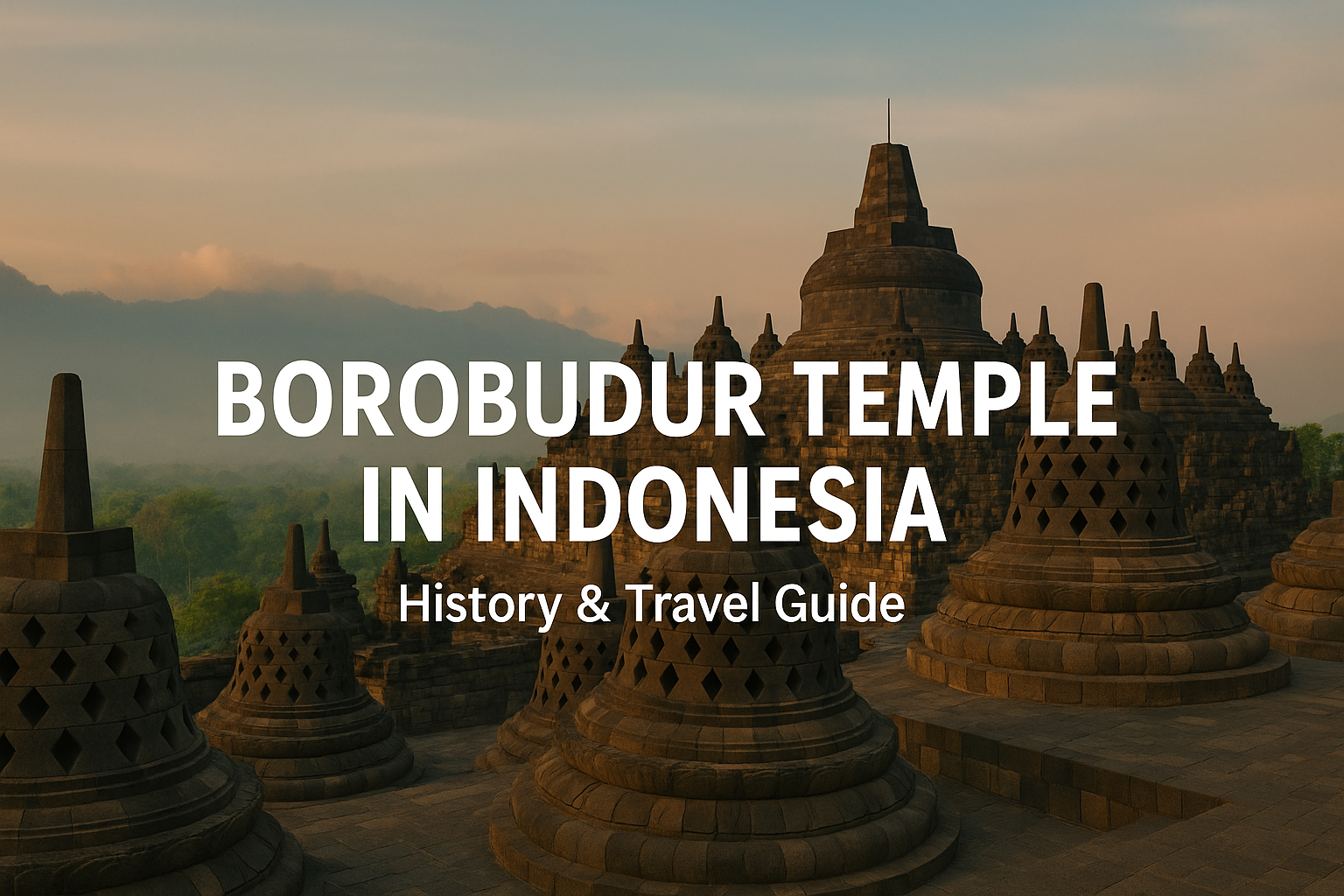The Eternal Wonder of Borobudur: History, Architecture, and Cultural Legacy
Deep in the heart of Central Java, Indonesia, lies one of the most magnificent monuments in human history — Borobudur Temple. Rising majestically above lush green landscapes and volcanic mountains, Borobudur is more than just a stone structure; it is a testament to the spiritual devotion, artistic genius, and cultural synthesis of ancient Java.
Built in the 9th century, this UNESCO World Heritage Site remains the world’s largest Buddhist temple and continues to attract millions of pilgrims and travelers from around the globe. Beyond its massive scale, Borobudur carries within its stone carvings and architecture an intricate story of spirituality, philosophy, and civilization.
This article will explore the history, architecture, symbolism, cultural significance, and modern preservation efforts surrounding Borobudur — unraveling why it remains an eternal wonder of the world.
1. The Historical Background of Borobudur
1.1 Origins and Construction
Borobudur was constructed during the reign of the Sailendra Dynasty, around the 8th to 9th centuries CE. The Sailendras were known as patrons of Mahayana Buddhism, and their rule coincided with a flourishing period of cultural and religious expression in Java.
Historical evidence suggests Borobudur was built between 780 and 825 CE, predating the famous temples of Angkor Wat in Cambodia and even Gothic cathedrals in Europe.
The temple was constructed on a natural hill and shaped into a colossal stepped pyramid with nine platforms: six square and three circular. At the very top lies the main stupa, symbolizing enlightenment.
1.2 Forgotten and Rediscovered
Borobudur’s history is also marked by periods of abandonment and rediscovery. After the 14th century, the decline of Buddhism in Java and the rise of Islam led to the temple’s neglect. Layers of volcanic ash from nearby Mount Merapi and dense jungle gradually covered the site.
For centuries, Borobudur lay forgotten until 1814, when Sir Thomas Stamford Raffles, then Governor of Java under British rule, initiated its rediscovery. Excavations revealed the breathtaking structure beneath, and restoration efforts soon began.
2. Architectural Brilliance of Borobudur
2.1 Monumental Scale
Borobudur is an architectural marvel. It is estimated that over 2 million stone blocks were used in its construction, weighing a total of 3.5 million cubic feet. No mortar was used; instead, stones were precisely cut and interlocked with remarkable engineering skill.
The monument measures 123 meters (403 feet) in width and 35 meters (115 feet) in height. Despite centuries of erosion, earthquakes, and volcanic eruptions, its design remains intact.
2.2 Symbolism in Architecture
The structure of Borobudur represents the Buddhist cosmology, particularly the journey from the earthly world to enlightenment:
- Kamadhatu (The World of Desire): The base of the temple represents human life bound by passion and desire.
- Rupadhatu (The World of Forms): The middle platforms, with intricate reliefs and galleries, symbolize the realm where humans transcend desires but are still bound by form and name.
- Arupadhatu (The World of Formlessness): The three circular terraces with stupas symbolize the formless world — pure spiritual liberation.
- The Central Stupa: At the summit lies the largest stupa, representing Nirvana, the ultimate goal of Buddhism.
2.3 The Stone Reliefs
Borobudur houses over 2,600 relief panels and 504 Buddha statues. The reliefs narrate stories from Buddhist scriptures, such as the Lalitavistara (Life of Buddha), the Jataka tales (Buddha’s past lives), and the Avadanas (noble deeds).
These carvings serve as both spiritual lessons and artistic masterpieces, guiding pilgrims as they circumambulate the temple clockwise, ascending from the earthly base to spiritual enlightenment at the summit.
3. Religious and Cultural Significance
3.1 Pilgrimage and Rituals
Borobudur is not just an architectural marvel but also a sacred site. For centuries, it has been a center of Buddhist pilgrimage, particularly during Vesak Day, commemorating the birth, enlightenment, and death of Siddhartha Gautama (Buddha).
Pilgrims traditionally follow a ritual path, moving clockwise around each level, ascending step by step until reaching the great stupa at the top — symbolizing the spiritual journey toward Nirvana.
3.2 A Cultural Synthesis
Borobudur reflects a remarkable synthesis of indigenous Javanese culture and Indian Buddhist philosophy. While inspired by Gupta art from India, Borobudur’s style is distinctly Javanese, evident in the naturalistic reliefs, local flora and fauna depictions, and volcanic stone materials.
4. Decline, Rediscovery, and Restoration
4.1 Decline and Natural Threats
After its abandonment, Borobudur faced centuries of deterioration. Earthquakes, volcanic eruptions, and tropical vegetation caused significant damage. Additionally, looting and souvenir hunting further eroded its treasures.
4.2 Rediscovery by Raffles
In 1814, Sir Stamford Raffles received reports of a massive structure hidden in the jungle. He sent a Dutch engineer, H.C. Cornelius, who uncovered the monument. Early restorations began, but it wasn’t until the 20th century that systematic efforts took place.
4.3 Modern Restoration
The most significant restoration occurred between 1975 and 1982, led by the Indonesian government with UNESCO assistance. Over one million stones were dismantled, cleaned, and replaced. Drainage systems were improved to protect against tropical rains.
This massive project ensured Borobudur’s survival and cemented its place as a UNESCO World Heritage Site in 1991.
5. Borobudur in the Modern World
5.1 Tourism and Education
Today, Borobudur is Indonesia’s most visited tourist attraction, drawing millions annually. It is not only a spiritual site but also an educational treasure for historians, archaeologists, and students of art.
Museums around the complex showcase artifacts, models, and interactive exhibits to enhance visitors’ understanding of Borobudur’s legacy.
5.2 Challenges of Preservation
Tourism brings both opportunities and threats. Excessive foot traffic causes erosion of the stones, while climate change and volcanic activity continue to pose risks. Indonesian authorities now regulate visitor access, sometimes limiting numbers during peak periods to preserve the temple’s integrity.
5.3 Borobudur as a Global Icon
Borobudur is more than an Indonesian monument; it is a global symbol of Buddhist heritage and human creativity. It represents dialogue between past and present, East and West, religion and culture.
6. Symbolism and Philosophy
6.1 The Pilgrimage Path
Walking through Borobudur is not merely sightseeing but a symbolic spiritual journey. Each step upward signifies progress toward enlightenment.
- At the base, one encounters desires and illusions.
- On the middle levels, the reliefs teach moral lessons and stories of compassion.
- At the summit, the empty stupa reflects the emptiness of self, a key Buddhist teaching.
6.2 The Mandala Concept
The design of Borobudur is essentially a three-dimensional mandala — a sacred diagram used in Buddhist rituals. Its geometry reflects cosmic order and the path of meditation, guiding practitioners toward inner awakening.
7. Borobudur and Indonesian Identity
Borobudur is not just a religious monument but also a symbol of national pride. It represents Indonesia’s pluralistic heritage, blending Hindu-Buddhist traditions with local artistry.
In modern times, Borobudur stands as a cultural bridge, attracting global recognition while strengthening local identity.
8. Visitor Experience: What to Expect
For travelers, Borobudur offers a profound experience:
- Sunrise View: Watching the sunrise over Borobudur is one of the most breathtaking sights in Southeast Asia. Mist covers the valleys while the temple glows under golden light.
- Circumambulation Ritual: Visitors can follow the traditional path, walking clockwise around each level to absorb the stories carved in stone.
- Nearby Attractions: The surrounding area offers other temples like Mendut and Pawon, forming a sacred Buddhist triad.
9. Frequently Asked Questions about Borobudur
Q1: Why is Borobudur so famous?
Borobudur is the world’s largest Buddhist temple and a masterpiece of architecture and spiritual symbolism.
Q2: How old is Borobudur Temple?
It was built around the 9th century CE, making it over 1,200 years old.
Q3: Is Borobudur still used for worship?
Yes. Borobudur remains a pilgrimage site, especially during Vesak Day celebrations.
Q4: How many Buddha statues are in Borobudur?
There are 504 Buddha statues, many of which are seated in stupas.
Q5: Is Borobudur older than Angkor Wat?
Yes. Borobudur predates Angkor Wat by about three centuries.
Conclusion
Borobudur Temple is more than stone and sculpture — it is a living monument of human faith, art, and resilience. Its walls speak of devotion, its stupas reflect philosophy, and its endurance symbolizes the timeless pursuit of enlightenment.
From its construction under the Sailendra Dynasty to its rediscovery and UNESCO recognition, Borobudur remains an eternal wonder, inspiring awe in pilgrims, historians, and travelers alike.
In every sunrise that illuminates its stupas, Borobudur whispers the same truth across centuries: that humanity’s greatest achievements are born not only from power but from the pursuit of wisdom and spiritual awakening.
JAWARA88
DAFTAR SEKARANG
JAWARA88
Borobudur Temple history




Kalau ingin coba slot yang gampang menang, cek Joker81 SLOT, recommended!